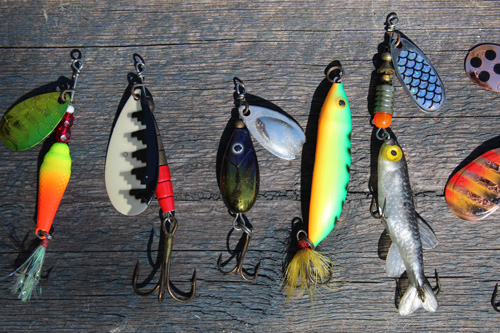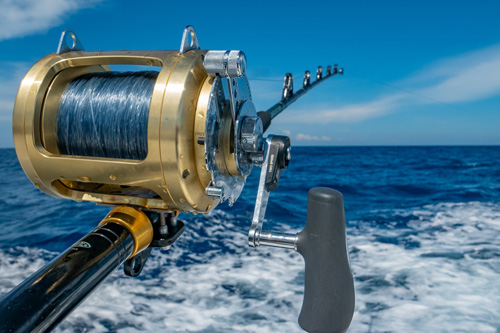When you think of fishing, what types of fish come to mind? It probably depends on where you're going fishing; but, we can probably assume that bass are somewhere near the top of your list. Bass fishing is considered one of the top fish for anglers across the United States. It can be quite intimidating to fish for bass, but Fishmaster is here to help. This blog will serve as a guide to bass fishing for those of all skill levels.
The Right Equipment for Bass Fishing
First, you will want to make sure you have all of the proper equipment for bass fishing. Here’s a quick rundown of everything from rods and reels to lures and bait to boat prep.
Bait
Choosing the right bait for bass can be overwhelming because there are so many different kinds of bait to choose from: crankbaits, topwater baits, spinnerbaits, jigs, jerkbaits, and more. Bass will go after baits both on top of the water or deep below, and there are specific bait types that work best for both situations. Top-water bass baits are used to attract bass to the surface of the water. Although these may be better suited for more advanced anglers, they can make small movements or ripples in the water and mimic minnows – which happen to be a smaller fish that bass go after. For the bottom-feeding bass, there are other types of baits that can be used. These include spoons, grub and crankbaits. Spoons and grub are going to be for the lazier fish; while, crankbaits are more versatile and commonly used for maneuvering through the plant life at the bottom of the water. Spoons also are good when dealing with the plants underwater. These are good for moving through any plant life that is at the bottom of the water you are fishing in. Choosing the best bait for bass will help ensure your fishing trip is successful.

Rods and Reels
Perhaps the most important part of fishing is your rod and reel. For beginners, it is recommended to start with a spinner rod and reel combo. These are easy to use and cost effective. These rods are made for both delicate nibblers and big backboned game fish – like bass. They are smooth and work with a variety of baits and lures.
If you are looking to invest a bit more or are a more advanced angler, you could try the baitcasting rod and reel combo. These rods take more practice than the other, but they are higher performing and offer more versatility when it comes to bass fishing. These rods are specially designed to help improve your casting, but require more accuracy on your end than other options.

Boat Preparation
If you decide to go bass fishing on your boat, there are a few things you might want to consider adding. Rod and reel holders can be helpful for fishing of all kinds, but especially bass. Our holders connect to your T-Top and allow for extra storage so you are always prepared and have a variety of rods and reels ready for easy swap outs when needed. If you plan on staying out for extended amounts of time, you will also want to make sure you have proper protection from the elements and harmful UV rays. Having proper shade on your boat can make or break your time fishing. Additional things to consider for preparing your boat for your trip include seating, fishing tools, t-tops, and casting platforms. All of these things are completely optional, but help create the optimal fishing experience for serious anglers.

Personal Preparation
You'll also want to make sure you have the right clothing for fishing. Whether you are spending a few hours or all day/night on your endeavor, wearing the proper clothing is important. You will want to dress for the weather and where you will be fishing from. It is important to check the weather before you go out so you can plan accordingly.
Best Time for Bass Fishing
Bass love warm waters. The best time of year is typically the spring or summer when water temperatures are between 60 and 80 degrees. Bass begin to spawn in the spring and during the summer they are in full force and more actively feeding.
Note: Bass spawns are slightly harder to catch because they are extremely active which means they are slightly faster than older bass.
Bass tend to avoid the sun, so during the hotter and sunnier days, they will be deeper in the water. Typically, most people will go out early in the mornings when it is cooler for bass fishing because they are closer to the top of the water. The fall is decent for bass fishing because they are actively feeding before going into winter and, depending on your location, they are more than likely enjoying the cooler and less sunny days.
A general rule of thumb when it comes to bass fishing is to go out during dawn or dusk as they will be closer to the top of the water. If you are out at midday, try to go to some more shady areas as they will usually avoid the sunlight – closer to banks with trees overhanging. Most of all, make sure to enjoy your time and be patient.
Special Techniques for Bass Fishing
Bass love calm water; so whether you are on land or in a boat fishing, you will want to make sure the water is mostly calm. If the water is choppy or there is a lot going on, the bass will tend to hide out – making them harder to catch. Another tactic to help catch this popular game fish is to make sure your bait looks as real as possible – and if you are able to, go with the color red. These two small tricks will help you catch a bass in no time.
You are also more likely to catch them if you are around stumps, rocks, or covered edges. Use the water’s surface to make a little noise once you get to the area and move your bait around the water, this will attract the fish and entice them to come out. To do this, cast your line out, but instead of letting it go into the water, let your lure tap and skip on it a few times. This movement will create just enough noise for the bass to notice and be intrigued.
While this might seem like a lot of information to take in, bass fishing is fun and for anglers of all ages and you’ll get the hang of it with practice. Once you have gotten all of your equipment figured out and are ready to hit the water – by boat or land – check out this interactive map to find the best spots for fishing in your area.












Comments
Please log into your account to post comments